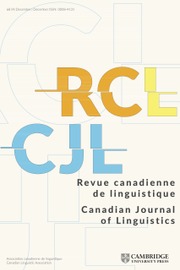No CrossRef data available.
Article contents
Underlying vs superficial grammatical relations
Published online by Cambridge University Press: 27 June 2016
Extract
This paper is based in part on evidence and insights found in various studies. These studies had as their objects to prove (or at least to demonstrate the plausibility of) either an analysis of a language or a theory of grammar. Their evidence, in addition to that which is new here, demonstrates the difficulty of using superficial relational information for semantic interpretation. It may be noted that, some years ago, Jespersen pointed out many such difficulties, though not with the orientation of relating syntax to semantics.
- Type
- Research Article
- Information
- Canadian Journal of Linguistics/Revue canadienne de linguistique , Volume 15 , Issue 1 , Fall 1969 , pp. 11 - 26
- Copyright
- Copyright © Canadian Linguistic Association 1969
References
1 This is an extended version of “The Notion of ‘Grammatical Relation’ in Transformational Theory,” presented in June 1968 at the annual meeting of the Canadian Linguistic Association, Calgary. A version also appeared in Recherche sur la traduction automatique, 11ème rapport semestriel (CETADOL, Université de Montréal, Oct. 1968) pp. 35-55.
2 Mainly: Partée, B. Hall, “The Subject Relation” (Ph.D. dissertation, M.I.T., 1965)Google Scholar; Gruber, J., Studies in Lexical Relations (Ph.D. dissertation, M.I.T., 1965)Google Scholar; Gruber, J., “Look and See”; Lg 43 (1967) pp. 937–47 Google Scholar; Langendoen, T., “Some Problems Concerning the English Expletive ‘it,’” POLA 13 (Ohio State Univ., 1965)Google Scholar; Langendoen, T., “The Syntax of the English Expletive ‘it,’” in Dineen, (eds.), 17th Annual Round Table Conference, Georgetown Monograph No. 19 (Georgetown Univ. Pr., 1966), pp. 207–16 Google Scholar; C. Fillmore, “Proposal Concerning English Prepositions,” in ibid., pp. 19-33; Matthews, H., “Le Cas échéant” (unpublished ditto, M.I.T., 1967); Dineen, (ed.), 17th Annual Round Table Conference, Georgetown Monograph No. 19 (Georgetown Univ. Pr., 1966)Google Scholar. More recent work includes: Fillmore, C., “The Case for Case,” in Bach, and Harms, (eds.), Proceedings of the 1967 Texas Conference on Language Universals (NY: Holt, Rinehart & Winston, 1968), pp. 1–88 Google Scholar; Robinson, J., “Case, Category and Configuration,” ERIC/PEGS 64 (Washington, July 1968)Google Scholar; Anderson, J. M., “Ergative and Nominative in English,” JL 4 (1968) pp. 1–32.CrossRefGoogle Scholar
3 O. Jespersen, Essentials of English Grammar (repr. by Univ. Alabama Press, n.d.), Chapter 11.
4 We do not offer any clarification for this very unsatisfactory category, also called ergative by Fillmore (ref. in fn. 2).
5 These stylistic considerations plague research in this area and little has been done except to ignore them. They seem to be related to the difficulty of finding a context appropriate to the non-mention of certain nominals, such as agent. Disjunctive emphasis (the difference in French between moi on one hand and je or me on the other) usually makes these nominally barren sentences acceptable. In this connection, note the acceptability of “this key locks your door and that one locks your window” or “this key locks your door and that one unlocks it.”
6 See Th. R. Hofmann, “Relational Functions,” Recherche sur la Traduction Automatique, 9ème rapport trimestriel (CETADOL, Université de Montréal, Jan. 1968), pp. 32-40.
7 The usual example of verb not agreeing with its “logical subject,” may be there’s some birds on the front lawn
there’s lots of toys in the playroom
objected to by some, by arguing that there’s is a unique element which forms a sentence with a following nominal, somewhat similar to the way French voici can be described.
8 But not in:
*she is easy to sound good to
apparently because this construction requires an agent as the subsequently deleted subject of the infinitive verb. (Note that this explanation is couchable only in terras of agent and perhaps subject.)


